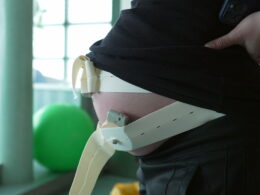During my first pregnancy, I decided to forgo traditional birth classes in favor of creating my own curriculum. Natural, physiologic unmedicated labor was my goal, and, as a psychology graduate student and athlete, I was confident I could hack my way to a smooth labor.
I had seen enough movies and heard enough stories to know the skills I would need for labor. My birth prep would model after marathon training with a few psychological tricks thrown in for pain management. Marathon training techniques would take care of my needs for stamina, effective breathing techniques, and a high pain tolerance. Psychology hacks would help me get in the right mind space, manage the pain, and stay on track with my birth training plan. Throughout my pregnancy, I planned to practice the different skills I would need to master so that by the time birth came, I would be a pro.
This might sound like a convincing plan to some readers. It sure sounded good to me at the time, but there is a reason that birth classes are not like marathon training.
My labor training plan
As with all research studies with a sample size of one (in this case, me), it’s hard to tell what parts of the training plan were helpful and which were not. For example, I decided that a great way to simulate contractions would be to rotate between freezing and warm water every few minutes when I took showers. Cold showers are known for increasing positive mood, but the jury is out on whether they actually increase pain tolerance over time [1]. Did taking the simple joys of a warm shower away from my very pregnant self make labor any more pleasant? Probably not. But, I did achieve my goal of natural labor, so I hesitate to knock it too hard.
However, with the benefit of hindsight, I know for sure that some aspects of my training plan were downright silly.
Thinking birth would be just like a marathon: pairing a playlist with hill workouts
One aspect of my training plan that I was most excited about was the playlist I created and played while running hills. Yes, you read that correctly—I subjected my pregnant self to hill workouts throughout all nine months!
I knew that the neurotransmitters released through running were similar to those released during birth [2]. In both, oxytocin—the brain’s little happiness conductor—is released at higher rates than usual. Additionally, the increased endorphins from running during the second and third trimesters are related to decreased pain perception and lower levels of the stress signal, cortisol, during labor [3].
In an effort to maximize these benefits, I planned to play my running playlist during labor. In the leadup to delivery-day, I exclusively played this list while doing intense workouts (which I will admit by month nine were more like intense waddles). By doing this, I was tapping into psychological theories about state dependent memory and classical conditioning. These theories suggest that pairing a stimulus—like a playlist—with a mental state (created by the brain chemicals released during exercise) can lead to the experience of the mental state when the paired stimulus is introduced without the original stimulus (in this case, exercise).
To break that down a bit more simply, I thought that by only and always playing that playlist when exercising, my brain could eventually be tricked into releasing happy and stress relieving chemicals when playing the playlist without exercising (that is, while I was in labor!). This would be beneficial during labor because those chemicals improve labor progression and maternal-infant bonding [4].
Realizing that birth is not like a marathon: pump-up music doesn’t help!
So you can imagine my excitement after months of prepping when I realized, in the wee hours of the morning, that I was in labor and could finally put my experiment to the test. I got out my headphones, sat on my giant exercise ball, and waited for the happy hormones to flow as Ke$ha’s hit song Tik Tok rolled over me.
Immediately, everything felt wrong. Stress began to fill my body, and I felt an overwhelming need to shut off the lights and turn off the music. I took off my headphones and switched off the lights. Relief filled my body, but I was not ready to give up on my experiment yet. I went and got a speaker, hooked up my playlist, and this time—at a slightly lower volume—Kelly Clarkson’s Since You Been Gone filled the room. At first the beat was nice to sway to, but when the chorus filled the room, I was compelled to turn it off.
What I listened to instead
I labored in the quiet dark room until it was time to go to the hospital. My husband put in the directions and turned on a favorite playlist of ours. It was calmer than the one I had prepped for labor, and a welcome distraction from the discomfort of sitting in the car.
Once in the birthing room, my husband went to set up the speaker and asked what he should play. This time I listened to my body and instructed him to put on “the calmest, nicest, slowest” playlist he could find. I then went and hid from the bright hospital lights in the bathroom’s (warm) and den-like shower until I was ready to push.
During intense labor, I didn’t want equally intense coaching or even encouragement
I had coached my husband that he should pump me up during pushing. I had run cross country in school and knew there was nothing like a cheering crowd to get through the home stretch sprint to the finish line. Yet his motivation and excitement quickly became overwhelming, and I found myself shushing him, preferring just to focus on the repetition of counting my breaths.
“One. two. Three. Four. five. Six. seven. Eight. Breathe. Push. One. two. Three. Four. five. Six. seven. Eight. Breathe. Push. One. two. Three. Four. five. Six. seven. Eight. Breathe. Push.” became my mantra as I leaned into labor and the world around me disappeared. Every interruption—to check the baby’s heartbeat, to switch positions, responding to each new doctor or nurse who introduced themselves, even answering the question of how I was doing—felt like enormously weighty tasks.
Then, suddenly, I was holding my beautiful baby and came back to myself, despite the glorious oxytocin high of post-childbirth. I remember joking with the midwife assistant about how strange it must be to only really “meet” their patient after labor ended because the birth process is so all mentally encompassing for the mother.
The flaws in my labor training plan
I see now that the biggest mistake with my labor training was failing to consider the psychological experience of birth itself. I was approaching birth as if it was something I needed to control to get through it, the way you control yourself to keep running a long race or push through a tough workout.
Birth is exactly the opposite. Labor is something that happens to the pregnant woman. When the mother is in a safe and calm environment, and if she has the right kind of support from her provider and partner (and/or doula), her body will do most–if not all–the work. Her brain will release the needed neurotransmitters and hormones without pairing a playlist. Her body will do the hard work of changing to push a baby out whether or not she did hill workouts. Labor will be painful no matter how many cold showers she takes leading up to her baby’s birthday.
That being said, there is value to ensuring you are as physically and mentally prepared as possible (and you can check out this article for ways to do that!). Perhaps most important of all is to carefully consider the environment in which you plan to labor and give birth. In my next article, I plan to delve into everything I’ve since learned about the ideal birth environment, and how it can help women prepare themselves and their surroundings for birth—playlist not required.












L and D is about relaxing and listening to your body in a safe comfortable environment. I was used to doing exercise and manual labor, so the labor in childbirth felt very much the same. Not painful. Pain results from tension and resistance.
Not always.